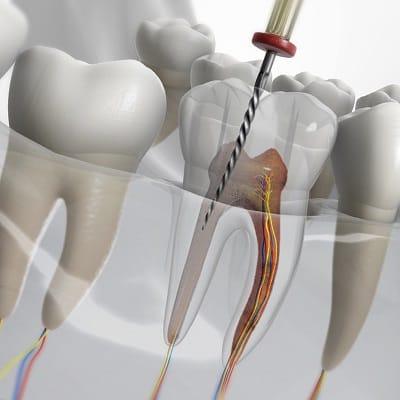Root canal-treated teeth can last a lifetime if properly cared for. However, treated teeth may not totally recover. You may have pain or get an illness months or years after treatment. You have another chance if your tooth doesn’t recover or develops new issues. A second surgery may save your tooth and expedite recuperation. If a previously treated tooth hurts, see an endodontist about retreatment.
What is Root Canal retreatment?
Before a root canal retreatment, the crown and packing material must be removed, the root canals cleaned, and the tooth repacked and capped. This is root canal retreatment.
“Reopen” the tooth to evaluate if root canal retreatment is necessary. A small hole on the tooth’s chewing surface is needed to reach the root canal. The crown, post, and core material must often be removed to access the root canals.
Before removing old root canal fillings, the canals are cleaned and inspected. They are then cleaned, shaped, and sealed before receiving a temporary filling or crown. After surgery and infection treatment, the endodontist installs a new crown or restoration on the tooth to restore its form and function.
Why Get a Root Canal Retreatment?
Suppose the initial treatment fails to cure small or bent canals, complex canal architecture, crown or restorative installation delays, or saliva contamination. In that case, the tooth may need an endodontic operation to recover. A tooth may also be at risk from new decay, loose, fractured, damaged crowns or fillings, or a tooth fracture.
Root canal therapy may avoid long-term infections, decay, and complex tooth structure. Retreatment treats remaining infections and prevents consequences. Complex dental structures may make cleaning and sealing teeth during the initial operation difficult. Dentists may return to repair missing or fragile canals. Retreating the tooth to remove decay, clean the canals, and seal it may prevent future issues.
How are root canals retreated?
If you keep having problems with a fixed tooth, your dentist will examine it.
The dentist must reopen the tooth to access the root canal. To access the affected area, crowns, supports, and fillings must be removed.
The dentist thoroughly cleans and disinfects the root canals to eradicate bacteria. Specialized processes and devices remove compromised or polluted tissue.
Cleansed canals are sealed with biocompatible material to prevent bacteria growth. This seals the tooth and prevents infections.
After the second root canal, the tooth is restored. A fresh crown or filling may be placed to safeguard and strengthen the operation. The amount of tooth structure left determines the best repair.
What to Expect Root Canal Exam Retreatment?
If your case is complex, your normal dentist may do a root canal retreatment. In rare cases of risk, they may recommend seeing an expert. Trust that your dental team has the skills and knowledge to give you the best care no matter what.
Your second root canal will be similar in many respects. Your dentist will remove diseased areas before using a specific chemical. You should get a crown later.
The process time may be the biggest difference between an original root canal and a retreatment. Your dentist will need to remove old filling material to access the inside of your tooth for retreatment, which may take longer.
Expect to relax during your session. With local anesthesia and may be sedation, surgery can be done without pain. You may be stiff and sore when you reach home. However, your mouth should feel normal soon.
Benefits of root canal treatment:
Root canals can enhance dental health and quality of life over time. Long-infected teeth may need extraction. Putting an implant in a bridge to fill the gap is expensive. Natural tooth restoration requires less maintenance than implants or bridges.
Other benefits of root canal treatment include:
- Root canal therapy kills infection-causing microorganisms, preventing jawbone, soft tissue, and facial gap infections.
- Chewing pain and swelling can result from tooth abscesses. A tooth is filled or crowned after a root canal, making it easier to bite, dig, and smile.
- After root canal therapy, a dentist will fill or crown your teeth to make your smile more natural.
Cost of Root Canal Treatment
The cost of root canal treatment in Islamabad starts PKR 18,000 for a single-root tooth. The cost of a root canal operation depends on the severity of the case, the dentist’s experience, and the dental clinic’s atmosphere and facilities. Complex or multi-rooted teeth raise the expense of the procedure. Make a dentist visit to get an accurate cost estimate.
Book a consultation!
Visit Enfield Royal Clinics for a consultation with our dental specialists, who prioritize offering high-quality care and customized dental plans to maintain oral health. We can help with everything from simple checkups to complex therapy. Call us for a consultation to start a happier dental life.









Leave a Reply